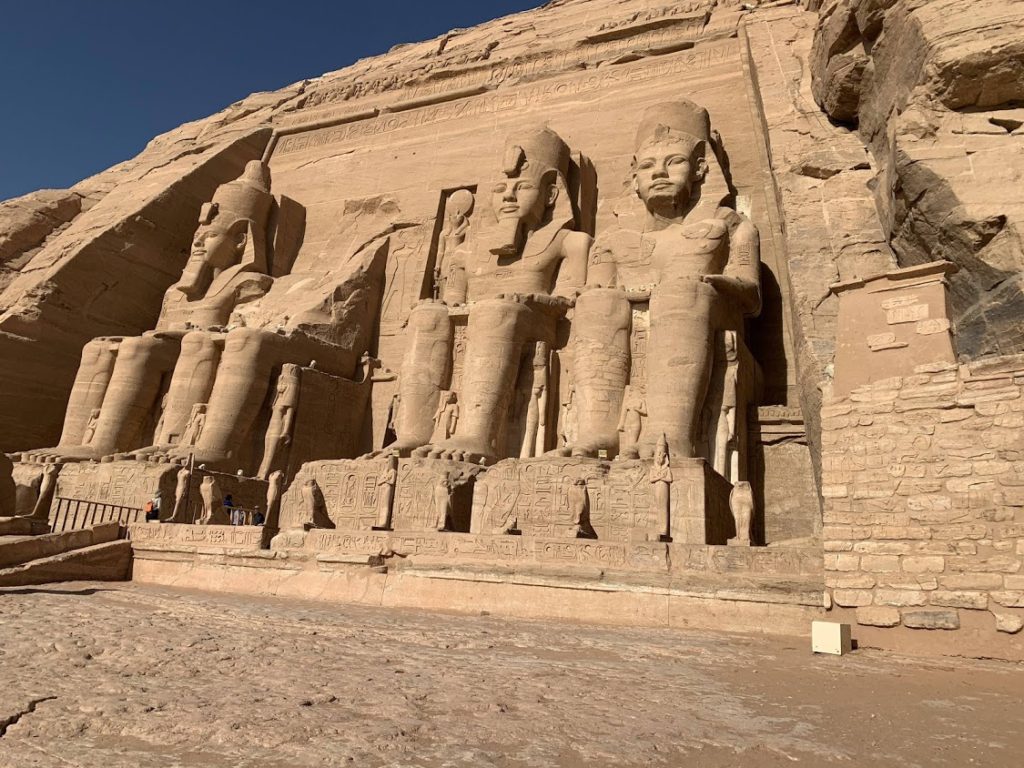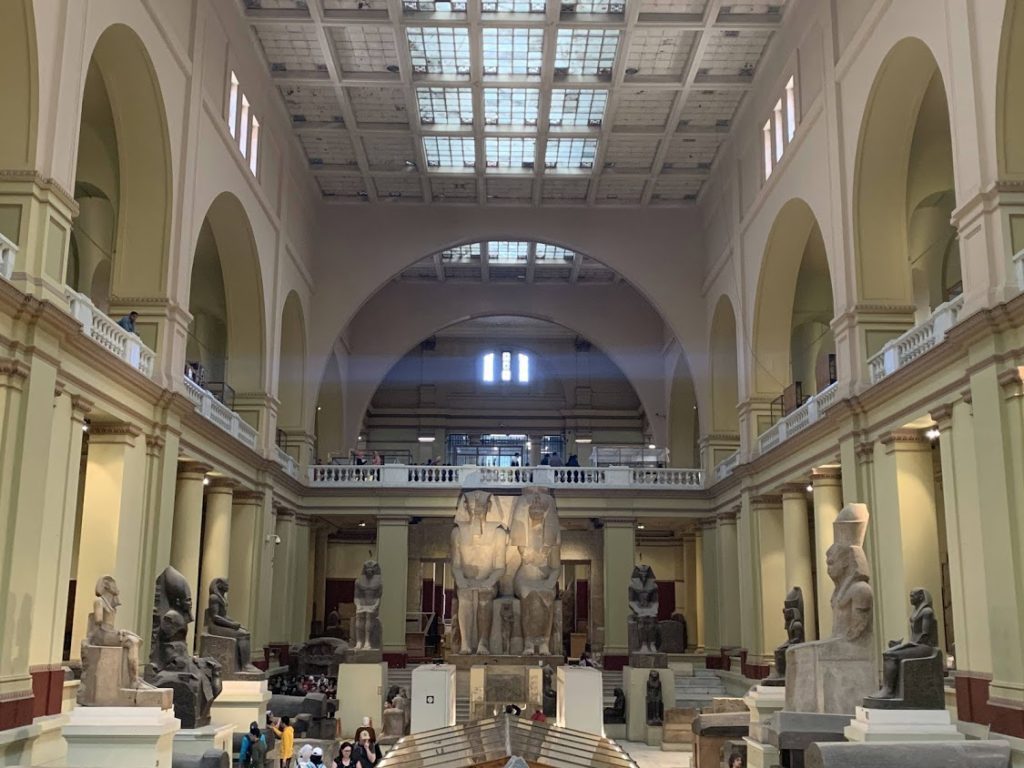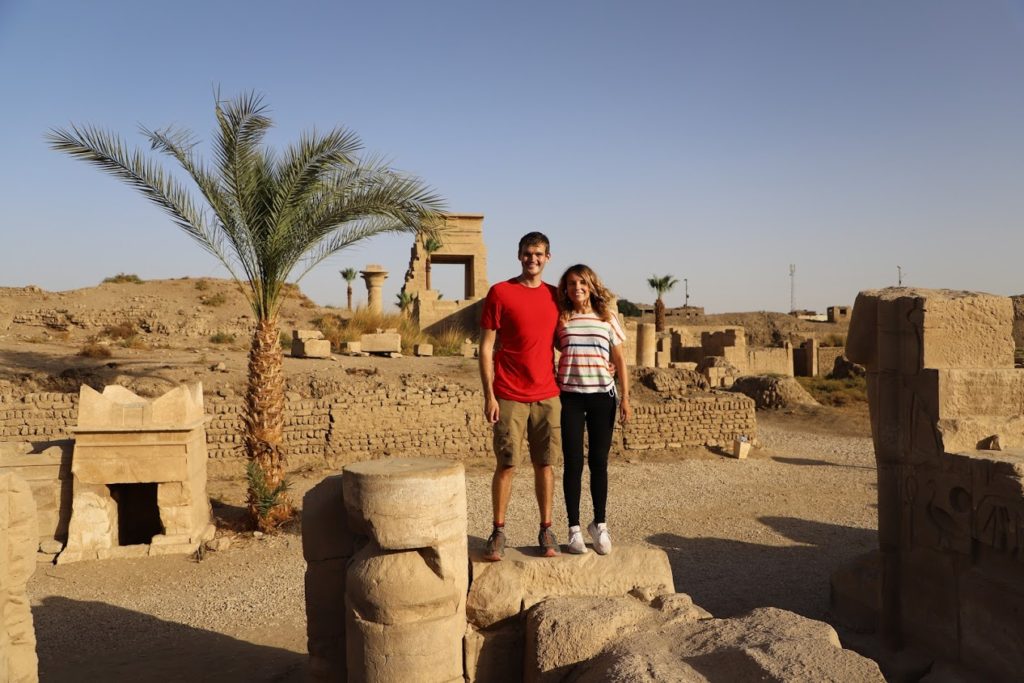Egypt is the home of last remaining ancient wonder of the world, Great Pyramids. After years of turmoil following the 2011 revolution things were finally picking up and felt safe enough for us to visit and explore Egypt.
We arrived into Cairo and it is fair to say Cairo is chaos incarnate. The traffic is absolutely INSANE! No one used the painted lanes on the roads. Horns are constantly honking. And the road is shared by everything from cars, buses to horses and camels so it’s an experience from the moment you arrive.
Great Pyramids
Our first stop was Giza right on the edge of Cairo to visit the Great Pyramids. Egyptian Pharaohs expected to become Gods in the afterlife. To prepare for the next world they erected temples to the gods and massive pyramid tombs for themselves – filled with all the things each ruler would need to guide and sustain himself in the next world.
The Great Pyramid belongs to Pharaoh Khufu and is the largest. Khufu’s son built the second pyramid and the third of the Giza Pyramids is considerably smaller than the first two built by Pharaoh Menkaure.

Though the size of the temples reflected the status of the Pharaohs, it’s interesting that Khufu’s son, Khafre pyramid looks bigger than the Great Pyramid of Khufu. The pyramid of Pharaoh Khafre was erected on slightly higher ground so gives an illusion of being taller. Was this Khafre’s attempt to one-up his father?

Also as we would discover nothing the Egyptians did was by coincidence. The pyramids were deliberately built in Giza as being at the west bank of river Nile, Egyptian mythology explains that this is the land of the setting sun, which is also the land of the dead.

The Sphinx
Our next step was the Sphinx. Egyptians built the Sphinx on the pyramids entry to protect the dead kings from spiritual attacks. The Sphinx has the body of a lion and head of a human. Carved out of a single block of limestone, Sphinx is claimed to be the oldest and largest known monolithic sculpture in the world.
There are 138 Pyramids in Egypt and we retraced the steps of the famous ones:
1. Bent Pyramid
Believed to be be the first attempt at building a smooth-sided pyramid, the Bent Pyramid is an engineering disaster dating back to 2600BC.

However, this disaster has managed to last through the centuries and although it looks different than the other pyramids of Egypt, it is still impressive. We were fortunate to visit the site as it only recently opened from summer 2019 to tourists.
Nick couldn’t resist going underground into the tunnel, I resisted as it was going down a massive ladder in the dark into a very small space. While I waited for Nick I was pondering whether I made the right choice and after ten minutes, I finally saw Nick emerge dripping head to toe in sweat so was thankful I didn’t go inside.
2. Red Pyramid
The Red Pyramid is the 4th largest pyramid in all of Egypt. These pyramids are great to explore as there are hardly any crowds as in Giza. Another difference is you are allowed to climb half way up the ancient temple and can even enter the tunnel down into the depths of the pyramids.

3. Step Pyramid
The step Pyramid of Sakkara, known to be the very first pyramid ever constructed in Egypt. Sakkara was the first capital of Ancient Egypt and the Step Pyramid is considered an essential phase in the evolution of the royal tombs until they reached the famous pyramid shape that we can see in Giza.

The purpose of the pyramid went beyond being just a tomb, it was built to allow the king to have a successful afterlife. Its said the step stage represents a crown in a shape that would enable the ascension of the king to the sky.
Egyptian Museum
After seeing the pyramids we made our way to the Egyptian Museum. Egypt is relocating the current museum to a brand new location by the end of 2020, hopes are high that the new $1 billion Egyptian Museum will put Cairo back on the tourist map following a difficult few years after the 2011 revolution and terrorist attacks. It will be the largest Archaeological museum in the world once its built.
We visited the current museum and houses an incredible 120,000 artefacts. The most fascinating part of the museum was the Royal Mummy Room. It may not be for everyone as you can gaze upon the preserved kings and queens from the Egyptian civilisation. The star of the exhibition is Ramses II. His mummified remains are perfectly intact, and its very weird to be looking at the remains of a man who was the most powerful in the world over 3,000 years ago.
The sombre atmosphere lifts when you move on to the other main draw of the museum, the King Tutankhamun collection. He is the most well-known Egyptian pharaoh because of his tomb, despite only ruling for a short while. He was only 9 years old when he became ruler. In 1922, British archaeologist Howard Carter unearthed an outstanding collection of treasures in Tutankhamun’s tomb in the Valley of The Kings, which revealed the Egyptian’s believe in the after life.

These include King Tut’s solid gold mask, his intricately carved throne and chariot, plus hundreds of other everyday items, all buried to make the Pharaoh’s next life as comfortable as possible. Not only was Howard Carter’s determination of great accord, he also brought the boy king, King Tut into the light and he is known as the symbol of Egyptology today.
Coptic Cairo
We then visited the Coptic area of Cairo. This is one of the most heavily guarded sites in Egypt with a police checkpoint, luggage scans and personal scans as its one of ISIS target areas.
Coptic Cairo dates to 6th century BC and was a strong hold for the Christians. The area is small and we have never seen so many churches in such a concentrated places. Its lovely to walk around to see the architecture and walk down the narrow streets. Other good places which we enjoyed walking around was the Muslim Quarter and Saladin’s Citadel.
After a week in Cairo it was time for us to fly to Aswan to start our four day cruise down the Nile to Luxor.
River Cruise on the Nile
We have always wanted to do a cruise down the Nile. It’s a 135 mile stretch of the river Nile from Aswan to Luxor with over 300 cruises sailing each day. At the airport we were greeted by our tour guide, Hani to begin the tour and our first stop was the Aswan High Dam.

Day 1 of the River Nile Cruise
Aswan High Dam
What is interesting is not the dam itself but the politics and history behind the building of the dam between 1960- 1970. It reflect the relationship the Egyptians had with the Soviets who funded £1.2billion to build the dam. It is a symbol of Soviet/Russian cooperation and is now the lifeline of Egypt by controlling the flood or dry seasons in the river Nile by storing and supplying water all year round.
Philae Temple
We then drove to the riverbank to catch a boat to Philae Temple. The temple sits on an island in the lake behind the Awan Low Dam. As a result, you need to take a brief boat ride to reach it. Originally, Philae was 500 meters away, but the temple was moved block by block in the 1960s to preserve it as the high dam was being built. This was a theme we would see in other temples and is quite extraordinary how much the temples got moved from their original location to preserve them.
Philae temple was built in honour of the goddess Iris, and it serves as a remarkable example of the cult that was built around her story, and one which includes Osiris and Horus.
After the temple it was time to board the boat for dinner. We dined with an amazing group of passengers from America also travelling the world. The caterers had organised the tables based on nationality and age groups. We would need this group more than ever over the next coming days.
Day 2 of the River Nile Cruise
Abu Simbel
Our second day involved very early start at 3am to drive down to Abu Simbel temples. It was a 4- 5 hour drive to Abu Simbel Temple as it near the border of Sudan.
There are two twin temples at Abu Simbel built by Ramses II. The larger temple dedicated to him and neighbouring one dedicated to Queen Nefertari. King Ramses II had more than forty wives, but only one of them got a massive temple build in her honour.

Like most temples we had visited, Abu Simbel once sat directed on the water’s edge. Yet in 1963, when the completion of a nearby dam threatened to flood them forever, the Egyptian government worked together with UNESCO to relocate the enormous, precious ancient sites back up the banks. When you see Abu Simbel its vast in space so was an archaeological undertaking unlike anything that had been attempted before.
Workers even recalculated the exact measurements needed to recreate the same solar alignment. To ensure that twice a year on the date of Ramses II ascension to the throne and his birthday, the rising sun would continue to shine through a narrow opening to illuminate the sculpted face of King Ramses II.
We got back to the boat by noon and spent the afternoon sailing down the Nile to Luxor. Luxor means ‘palaces’ and when we got off the boat the city looked very picturesque surrounded by so many ancient temples wherever we turned.
Temple of Kom Ombo and Crocodile Museum
Our first temple visit in Luxor was Kom Ombo temple dedicated to the crocodile god, Sebek and the falcon god, Horus. Interestingly, because the crocodile God was worshipped here they have found dozens of mummified crocodiles (yes you heard us correctly) that are displayed in the Crocodile Museum adjacent to the temple. A little gruesome to be sure, but we found it fascinating.
Edfu Temple
Our last stop on the second day would be Edfu Temple, the most intact temple in Egypt. The temple is dedicated to the God Horus – the god of protection who takes the form of a falcon. His image is depicted at the front of the temple.

Day 3 of the River Nile Cruise
Karnak Temple
We woke up early and took a horse and carriage to Karnak temple. It’s the second most visited site in Egypt. It’s the largest religious complex ever constructed and was developed around 2,000 BC. The building was never finished being built, but it was still great fun exploring the temple. The Ancient Egyptians built huge mud ramps to build these structures, and then removed them once they were finished constructing. This mud brick ramp was never removed, though, and still stands today!
It is dedicated to the Theban triad of Amun, Mut and Khonsu. The Great Hypostyle Hall has 134 massive columns inside. It’s incredible and was our favourite Egyptian temple.
Luxor Temple
We then drove 15 minutes to Luxor temple. It was originally build by Amenhotep III, one of the greatest builders of ancient Egypt. Interestingly enough, the Romans also added their own touches to it later (you’ll see a church inside and frescoes painted over the hieroglyphics) and there is a mosque built on top of it as you enter.
As the day was coming to a close we decided to do an optional tour the next day and take a hot air balloon over the Valley of Kings.
Day 4 of the River Nile Cruise
We woke up at 4am ready for the hot balloon to find out it was cancelled. There was cruise ship in Egypt that had been quarantined (not our ship!). Egypt had no idea of what the situation was so they decided to shut down the whole of Luxor that day. All tours were cancelled so we made a swift exit to our next destination Kenya.
We had a great time exploring Egypt. It really felt like it had recovered from the revolution of 2011 and tourism was finally picking up. It sad to think of what the impact of coronavirus will be on the Egyptian economy and tourism around the world.




















